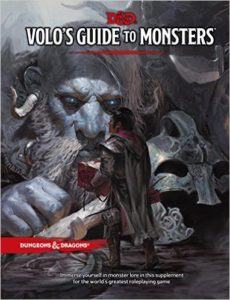 Hello students. Professor Crunch here with a review of the latest official Dungeons and Dragons Fifth Edition supplement book, Volo’s Guide to Monsters. We received a review copy of this book for this purpose and gave it away as a prize at AcadeCon 2016. {Yeah dude! I spent most of AcadeCon leafing through this lovely book. Michael wouldn’t allow me to have fun so I had to sneak it at the prize table. And I, of course, am Matthew Parody the Porphyrogénnētos, Prince of the Guiltless Night, Adjunct Professor of Improv at the East Campus, in the TwitterVerse I am known as The Paleonomicon & a friend to werewolves & dragons everywhere.}
Hello students. Professor Crunch here with a review of the latest official Dungeons and Dragons Fifth Edition supplement book, Volo’s Guide to Monsters. We received a review copy of this book for this purpose and gave it away as a prize at AcadeCon 2016. {Yeah dude! I spent most of AcadeCon leafing through this lovely book. Michael wouldn’t allow me to have fun so I had to sneak it at the prize table. And I, of course, am Matthew Parody the Porphyrogénnētos, Prince of the Guiltless Night, Adjunct Professor of Improv at the East Campus, in the TwitterVerse I am known as The Paleonomicon & a friend to werewolves & dragons everywhere.}
Quick Overview
This book is intended primarily for GMs. {Primarily is a strong word, me thinks. I think it’s a good 50/50 split down the middle.} It provides detailed information on the behaviors of nine specific monsters in order to help the GM provide a more vivid and exciting game experience. There is also a Bestiary chapter, which is essentially a mini Monster Manual, delivering almost 100 new monsters. {Wow. You counted. I’m impressed. I would’ve said “a plethora”}. Lastly there is an appendix with new beasts and another with 23 pre-made NPCs. These NPCs are presented in stat blocks just like the monsters. {My fave NPC has got to be the picture of Harry Skywalker.} For the players, there is a section with 7 new playable races and their various subraces. There is also a quick list of the racial traits for 6 monstrous races that are frequently used by players. {So BASICALLY 13 new playable PC races, with some more robust of detail than others but that is something that we not completely foreign to.}
So there’s this guy, Volo.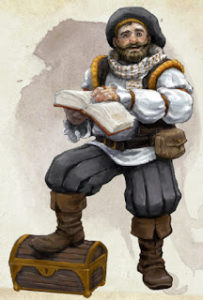
This supplement is framed in the context of being written by a character within the Dungeons and Dragons Forgotten Realms universe, Volothamp Geddarm. Volo is joined by Elminster Aumar. {I think that’s why I’m here. To be your Elminster, your hot sauce, your cardamom.} The two characters write notes back and forth to each other in the Monster Lore chapter. This gives the sense that Elminster was editing Volo’s work. {I see him more are a flavorant than an editor but since this is a finished product we’ll never know.}
While this is an entertaining addition, I personally don’t find any benefit from it. WotC doubled down on this extra dose of flavor, but didn’t do anything with it other than the book’s title and these little notes that add nothing to the content of the chapter. The material presented on these monsters is not written in Volo’s voice or style. It is standard D&D text, with titled segments and random charts. {It did exactly want it set out to do. WotC is going HAM with the Forgotten Realms at the moment. So they added these big ticket characters as spice to the work. If Volo’s and Elminster’s voice were permeating the work then it would’ve been a novel. They have those already. This is not that but is meant to tug on the heartstrings of those that might have feelings and ideas about these two clowns.}
I think reading this chapter if it was written in the context of D&D’s fiction might have gotten annoying and would not have been helpful, so I am thankful that did not happen. And it seems the writers of the book knew this ahead of time. But that being the case, why waste the time adding in the flavor? {Why? Because cinnamon and cardamom are delicious! Do you boil all your meals at home, sir?} It serves no purpose and is dropped after the first chapter of the book (except for a very few examples in the Bestiary chapter). It’s an amusing blur between the reality of gamers and their game, but beyond that, it’s pointless. {To quote some of the greats of our time “Colours of the world / Spice up your life / Every boy and every girl / Spice up your life / People of the world / Spice up your life / Aah” -Spice Girls It’s not pointless, it adds that je ne sais qui.}
Monster Lore
This chapter takes up about half of the pages in this supplement book. It highlights 9 monsters in the D&D world: Beholders, Giants, Gnolls, Goblinoids, Hags, Kobolds, Mind Flayers, Orcs, and Yuan-Ti. Why were these monsters chosen? {Umm, because some are iconic (Gnolls, Beholders & Mind Flayers), others are fun (Kobolds, Goblinoids & Orcs), Giants are very topical, and Yuan-Ti & Hags deserved a deeper delve.} I don’t know. The chapter’s intro highlights this odd choice stating that these tend to be used frequently and hopefully other monsters will get a similar 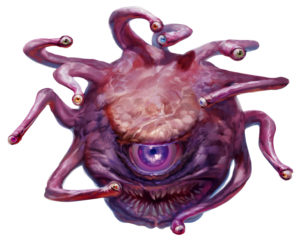 treatment in the future. {I hope so too. This note is directly from the writers of the book to the readers, which further destroys the illusion of Volo assembling this info from his travels and explorations.}
treatment in the future. {I hope so too. This note is directly from the writers of the book to the readers, which further destroys the illusion of Volo assembling this info from his travels and explorations.}
The content on each individual monster is deep and detailed. {Hey, and I just had a thought, some those flaws, bonds and stuff can be used as other PC options if you’re feeling squirrelly.} The focus is on how to use these monsters more effectively in your games by providing more flavor than is found in their respective Monster Manual entries. The content is as varied as the selected monsters, but it covers the range from history and lore to typical behavior to combat tactics. Most monsters have a map of a lair as an example for your encounters. They all have a variety of random tables that help easily generate details that fit the flavor. {It should be noted that these lairs, history, lore, etc are for the Forgotten Realms versions of these monsters. If your world is custom or home-brew you need not feel beholden to their words but use it as a springboard into deeper and darker places of your own designs.}
All of this information is well-written and incredibly vivid. {Yeah. They have tables for beholders’ eye, teeth, mouth & stalk specifics. You could even use some of these tables for quick rolling of pre-gens or NPCs, if you’re into that sort of thing. The world is your oyster.} It is the perfect source of inspiration for a GM who wants to make his or her game more exciting and realistic. And there is a fantastic amount of info about how to effectively use these monsters as more than just encounter fodder. I think that these details also serve to highlight monsters that some GMs might hesitate to use, even though this opinion contradicts what the authors say. Monsters like Beholders, Mind Flayers, and Yuan-ti are fantastic in encounters, but they truly shine as on-going threats that are the foundation of a campaign. {Great point, Caleb. I honestly never considered using a beholder other than a nasty monster set in the “hero’s” way. Now I see them as a big bad in their own right.} The details in Volo’s Guide is best used to make these monsters dangerous and effective over the course of a longer game.
Character Races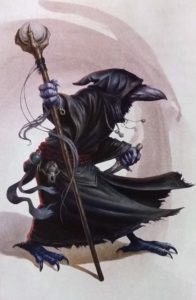
This is my favorite part of Volo’s Guide. {Co-signed!} I love using monstrous races as both a player and a GM. It also delivers what might be my favorite race, the Kenu, so I am a happy gamer. {As a huge Hellboy fan-boy I absolutely adore monstrous races. I don’t know why you love the Kenku so much but, maybe you don’t understand my love of Gnolls.} I also appreciate the breakdown of traits for the classic monsters that tend to get played frequently, such as the various goblinoids and kobolds (especially because they are all featured in the previous chapter). As a GM, I frequently use these monsters as recurring enemies and bolster their abilities with a few class levels, so this makes my job much easier. {13 new PC races! So much can be done with all this. Recurring bad guys, anti-hero games, villains or literally making a warband of murder-hobos.}
I haven’t had a chance to use the new races in a game yet, but all of their abilities seem functional and balanced within the confines of 5E. {I never dive too deep into mechanics and I also have not used these critters yet, but I will, soon.} Some of these abilities are very focused for certain types of campaigns, such as the Goliath’s Mountain Born and, well, everything that the Tritons get. It’s certainly not impossible to make use of these races and their abilities in a campaign not set in a fitting environment, and that is a great challenge to both players and GMs. However in these cases, maybe a few subraces or swappable abilities might be a good idea so that players still feel rewarded in their choices. {Tweek, tweek, tweek and roll with the punches people.}
Other abilities are flat-out crazy. The Aasimar’s Radiant Soul, Radiant Consumption, and Necrotic Shroud are game-changers. {These angel-people are crazy with too many sub-races if I’m honest.} But they are balanced out by being once per long rest abilities. The Goliath’s Stone’s Endurance makes them a damage-soaking power house. The LIzardfolk’s Cunning Artisan seems pointless but is, in fact, a source of infinite money. {What does everyone need money for?!? Especially a lizard-person.} And the Tabaxi’s Feline Agility is absolutely bonkers, especially when paired with the Monk and Rogue classes. {By the gods, the KittyKatMen are insanely fast, Speed Force quick so podcasts might say.} I love all of these, mostly because they remind me of older editions where PCs had a sense of huge, heroic power. {Okay, no problem, I’ll give the Firbolgs some love. These critters are the perfect fusion of fey & monster. Thanks to these rules now we can all live out our dreams of an ancient Irish mythological campaign.}
Bestiary
When it comes to monsters, more is always better. This chapter gives GMs a lot of monsters that support the monsters that were highlighted in the Monster Lore chapter. For example, there are new Beholders and Giants, variant Gnolls and Kobolds, and a ton of creepy Yuan-ti. There are also some classic monsters, like Boggles,  Dinosaurs, and Darklings. {Velociraptors are sized Tiny so I could have one as a familiar. Baller.} And there are some really crazy monsters, like the Flail Snail, Cranium Rats, and Vargouille. {Yowza, these ones were weird.} A few personal favorites show up, specifically the Shadow Mastiff and Guard Drakes. {Now I know why you love Umbreon so much and want a Dragon-type Eevolution so badly, Prof Crunch.}
Dinosaurs, and Darklings. {Velociraptors are sized Tiny so I could have one as a familiar. Baller.} And there are some really crazy monsters, like the Flail Snail, Cranium Rats, and Vargouille. {Yowza, these ones were weird.} A few personal favorites show up, specifically the Shadow Mastiff and Guard Drakes. {Now I know why you love Umbreon so much and want a Dragon-type Eevolution so badly, Prof Crunch.}
This chapter is a great resource for any campaign, but it works best when used in connection with a monster from the Monster Lore chapter. It also serves as a good source of inspiration for anyone looking for a unique encounter.
{Nothing screams unique like a dual-shield-wielding fire giant.}
Appendixes. Appendices? {Don’t ask me. I got rid of that rabbit organ years ago.}
The majority of the info here is an extension of the Bestiary. There are a few new Beasts. Are these necessary? I don’t think so. But if you need to know the stats of a Cow, it’s here. {Cow you mention but not the Aurochs? The dire cow, the pre-crow, the terrestrial version of Auðumbla! And in the flavor text it says that orcs ride them to battle. What?! That’s awesome.}
On the other hand, the NPCs are very useful. {Did you see Harry Skywalker back there? That kid looks like he could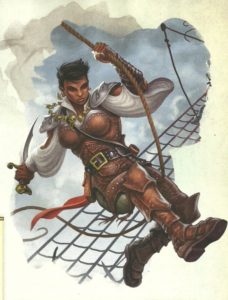 seriously do some damage.} While 5E allows us to build characters quickly and easily, it still takes time. These NPCs are pre-made examples of some classes from the PHB that you can easily grab and throw into a game session. At first it seems like these are all variants on the core classes, but they are really the core classes exactly, just with clever names for flavor. {Clever names? Sure but, dude! I would be remiss if i didn’t mention the Kraken Priest! The guy looks like a Draenai and acts like Davey Jones and doesn’t wear a shirt. Radical.}
seriously do some damage.} While 5E allows us to build characters quickly and easily, it still takes time. These NPCs are pre-made examples of some classes from the PHB that you can easily grab and throw into a game session. At first it seems like these are all variants on the core classes, but they are really the core classes exactly, just with clever names for flavor. {Clever names? Sure but, dude! I would be remiss if i didn’t mention the Kraken Priest! The guy looks like a Draenai and acts like Davey Jones and doesn’t wear a shirt. Radical.}
These could easily be used as enemies to fight or recurring characters for your players to deal with. They could also be shop owners or merchants if you are scrambling to get a non-combatant into the game. I appreciate the NPCs for their skills and stats more than their abilities. This is effectively a quick reference for skill modifiers to keep non-combat encounters challenging and interesting. {I think on that Internet that is called point and click features.}
Conclusion
Overall, this is a good supplement for Dungeons and Dragons Fifth Edition. It has resources for both the GM and the players, and it’s not overwhelmed with new class options (a problem that old 3.5 era supplement books had). It’s also gorgeous. It has fantastic art, like other 5E books, and the pictures are just as inspirational as the text. {I agree with most of your sentiments here sir but, to me this book is great. It’s definitely not a 100 but I would award this book an A-.}
However, the Monster Lore chapter establishes a very specific version of these 9 monsters. There’s nothing wrong with that. It supports the flavor that D&D as a brand is maintaining through its various books. But this is not the only version of these monsters. {But if you want to use these creatures as they are out of the book then do so. They are detailed and expansive enough to field as is. Don’t be afraid of doing your own thing either though.}
For a GM that is starting out or trying to develop his or her style, this book as a solid resource. {As solid as dragon scales.} It gives enough information to get the GM started and feel confident with utilizing a monster in a larger narrative function. But this book can be limiting in the sense that it says “this is the origin of that monster and this is how it operates in the game world”. Since tabletop role playing is all about cooperatively telling a story, there are many cases, in my opinion, where the story needs to express itself differently than what is presented in this book. So long as readers of this book recognize that its words are not law and they can change whatever they want to for their game, all will be well. {Well said. Think of this book as more of a diving board than a brick wall. Expand the horizons of your world.}
Volo’s Guide to Monsters is a great resource for D&D 5E, for both flavor and mechanical needs. But in my opinion, it’s a far better source of inspiration for whatever game you might be playing. At the very least, flip through it at your local bookstore and see if an idea jumps off the page at you. {I flipped through it A LOT. Well worth at least that. If it’s on your shelf you can grab for it when you want a Witherling to rise from the swamp to attack the party.}
And no matter what, if you are having fun, you are doing it right.
if you’d like to get your own copy of Volo’s guide and support our show, you can do here!






